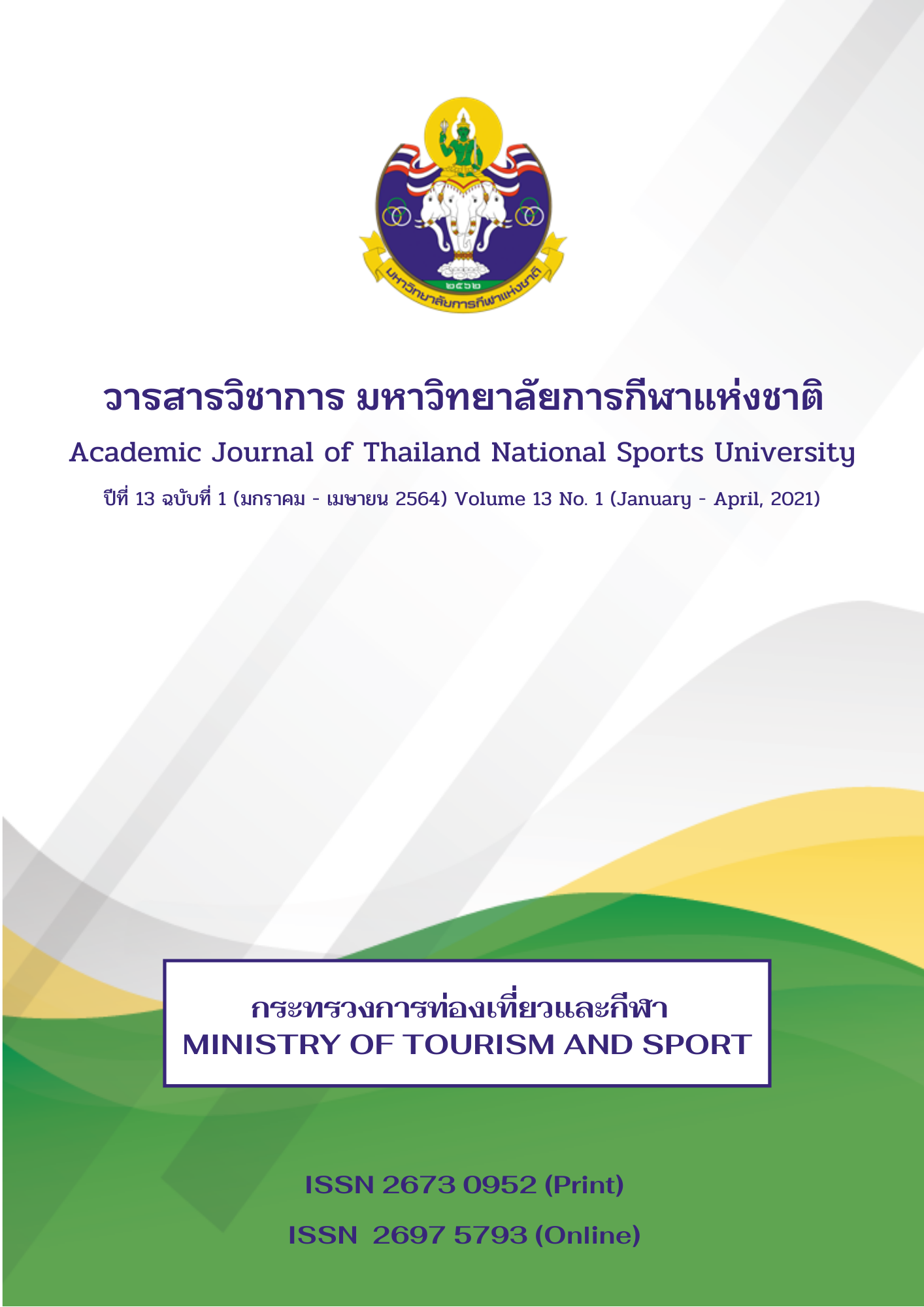THE EFFECT OF PERSONALIZED FLUID REPLACEMENT ON PHYSIOLOGICAL RECOVERY AFTER HALF-MARATHON RUNNING
Main Article Content
Abstract
Long-distance running generates heat accumulation and physiological stress, especially in cardiovascular and thermoregulatory systems. Proper fluid and electrolyte replacements have been reported to prevent adverse effects during exercise. Nevertheless, whether the benefit of personalized fluid replacement continues to the recovery period after half-marathon running remains unclear. Therefore, this study aimed to compare the effect of fluid replacement protocols on physiological recovery after half-marathon running. Eight healthy male runners (age 34.50 ± 4.8 yr., BMI 23.60 ± 1.8 kg/m2, body fat 18.82 ± 4.6%) performed two sessions of 21.1 km running with self-paced speed. The subjects received either Personalized drinking (PD; 70% of water and 100% of sodium loss matching individual sweat) or Ad libitum (AD; drinking water as much as desired) in a random order. Body weight, sodium loss, and plasma osmolality were measured before and after running, while heart rate (HR) and mean body temperature were monitored at 0-minute, 5-minute and 10-minute time points after completion of running. The running pace and volume of fluid replacement between AD and PD trials were not significantly different. The percentage of water intake, when compared to bodyweight loss, was significantly higher in the PD than AD trials (76.6% vs. 39.4%). Consequently, bodyweight loss in the AD trial was 80% higher than the PD trial. At 0-minute, HR of the subjects in the PD trial was lower than AD (p < 0.05). In addition, mean body temperature at 5-minute and 10-minute after finishing half marathon in the PD trial was lower than that of the AD trial (p < 0.05). These findings suggested that personalized fluid replacement during half-marathon running would be beneficial to physiological recovery, possibly due to maintaining thermoregulation and plasma volume.
Article Details
The published article is a copyright of the Academic Journal of Thailand National Sports University. The passage appeared in each article in this academic journal is a perspective of each author which is not related to the journal. Each author is required to be responsible for all components of his/her own article. If there are any mistakes, each author must be responsible for those mistakes on his/her own.
References
Baker, L. B. (2017). Sweating rate and sweat sodium concentration in athletes: A review of methodology and intra/interindividual variability. Sports Med, 47(1), 111-128. doi:10.1007/s40279-017-0691-5
Bardis, C. N., Kavouras, S. A., Adams, J., Geladas, N. D., Panagiotakos, D. B., & Sidossis, L. S. (2017). Prescribed Drinking Leads to Better Cycling Performance than Ad Libitum Drinking. Medicine and science in sports and exercise, 49(6), 1244-1251.
Bongers, C. C. W. G., Hopman, M. T. E., & Eijsvogels, T. M. H. (2017). Cooling interventions for athletes: An overview of effectiveness, physiological mechanisms, and practical considerations. Temperature (Austin, Tex.), 4(1), 60-78. doi:10.1080/23328940.2016.1277003
Bruce, R. A., & Lovejoy, F. W., Jr. (1949). Normal respiratory and circulatory pathways of adaptation in exercise. The Journal of Clinical Investigation, 28(6Pt2), 1423-1430. doi:10.1172/JCI102207
Bruce, R. A., & Pearson, R. (1949). Variability of respiratory and circulatory performance during standardized exercise. The Journal of Clinical Investigation, 28(6Pt2), 1431-1438. doi:10.1172/JCI102208
Costill, D. L., Kammer, W. F., & Fisher, A. (1970). Fluid ingestion during distance running. archives of environmental health: An International Journal, 21(4), 520-525. doi:10.1080/00039896.1970.10667282
Dugas, J. P., Oosthuizen, U., Tucker, R., & Noakes, T. D. (2008). Rates of fluid ingestion alter pacing but not thermoregulatory responses during prolonged exercise in hot and humid conditions with appropriate convective cooling. European Journal of Applied Physiology, 105(1), doi:10.1007/s00421-008-0876-6
Durnin, J. V., & Womersley, J. (1974). Body fat assessed from total body density and its estimation from skinfold thickness: Measurements on 481 men and women aged from 16 to 72 years. Br J Nutr, 32(1), 77-97.
Goulet, E. D. B., & Hoffman, M. D. (2019). Impact of ad libitum versus programmed drinking on endurance performance: A Systematic review with meta-analysis. Sports Medicine, 49(2), 221-232. doi:10.1007/s40279-018-01051-z
Hosseinlou, A., Khamnei, S., & Zamanlu, M. (2014). Voluntary drinking versus imposed drinking in the methodology of investigations about the drinking-induced thermoregulatory sweating. International Journal of Clinical and Experimental Medicine, 7(10), 3757-3762.
Lindsay B. Baker. (2017). Sweat Testing Methodology in the Field: Challenges and Best Practices. Sports Science Exchange, 28(161), 1-6.
Maughan, R. J., & Leiper, J. B. (1995). Sodium intake and post-exercise rehydration in man. Eur J Appl Physiol Occup Physiol, 71(4), 311-319. doi:10.1007/BF00240410
Merson, S. J., Maughan, R. J., & Shirreffs, S. M. (2008). Rehydration with drinks differing in sodium concentration and recovery from moderate exercise-induced hypohydration in man. European Journal of Applied Physiology, 103(5), 585. doi:10.1007/s00421-008-0748-0
Montain, S. J., & Coyle, E. F. (1992). Influence of graded dehydration on hyperthermia and cardiovascular drift during exercise. J Appl Physiol (1985), 73(4), 1340-1350. doi:10.1152/jappl.1992.73.4.1340
Sawka, M. N., Burke, L. M., Eichner, E. R., Maughan, R. J., Montain, S. J., & Stachenfeld, N. S. (2007). American College of Sports Medicine position stand. Exercise and fluid replacement. Med Sci Sports Exerc, 39(2), 377-390. doi:10.1249/mss.0b013e31802ca597


